For three horribly sweltering days in the summer of 1995, Chicago endured the deadliest stretch of heat ever recorded in the United States. The death toll ultimately numbered an estimated 739. Most victims were elderly and infirm and lived in the city’s poorest neighborhoods: Englewood, Fuller Park, and Roseland, to name a few. For reasons ranging from illness and immobility to poverty and fear, none were prepared for a weather event of such magnitude. The same was true for City Hall, firefighters, paramedics, police officers, and others whose belated attempts to mitigate this disaster proved largely ineffectual.
On Wednesday, July 12, one day before Chicago morphed into a giant blast furnace, the mercury rose to a scorching but not unprecedented 97 degrees. Worse was on the way. At 3:30 p.m. that day, the National Weather Service office in suburban Romeoville issued the first of several heat advisories but reportedly did not put out a more serious call-to-action statement. So actions of other kinds continued unabated: The White Sox played the Milwaukee Brewers at Comiskey Park. Mayor Richard M. Daley spoke during a ribbon-cutting ceremony to mark the grand reopening of Navy Pier. Life went on. And then, for many, it didn’t.
Here is a look back at what happened and why, as told by those who experienced one of Chicago’s greatest tragedies firsthand.
Thursday, July 13
By the afternoon, temperatures hit 104 at O’Hare and 106 at Midway. It felt like 125, according to the heat index, which factors in humidity. In what’s known as the heat island effect, brick buildings, asphalt parking lots, and tar roofs trapped the warmth and then radiated it outward. Add to that moisture-heavy air, a dearth of wind, and ever-present air pollution, and the city felt like a grubby urban sauna, even at night. “At midday,” a Los Angeles Times reporter observed, “those crazy enough to be out on Chicago’s streets seemed to be walking in a daze.”
Tom Skilling
Chief meteorologist for WGN-TV
We saw the heat coming for some time. But you were almost ridiculed when you’d say, “Hey, it’s really going to get hot.” I can remember people saying, “Oh, get over it. It’s summer in Chicago, and it gets hot.” I’d think, That’s not the whole story. There’s reason to be concerned from a safety standpoint.
Jerry Taft
Chief meteorologist for ABC-7
We put out the standard [advisory]: “Heat can kill. If you have elderly parents or you’re caring for the elderly, they need to have air conditioning.” We basically said the right things. But it’s almost like when there’s a severe thunderstorm watch: Nobody really changes what they do.
Meteorologist Skilling
It was a perfect storm in so many ways. To have a temperature of 104 and a dew point in the low 80s and not pop a thunderstorm was pretty extraordinary. A thunderstorm’s function in nature is to be the air conditioner. The air was quite warm and capped, which meant we had warm air aloft. And the lake breeze was completely defeated by a southwest wind gradient.
Fans had little effect, so residents without air conditioning tried to find relief in Lake Michigan and community swimming pools or by splashing in sprinklers and the gushing waters of 3,000 illegally opened fire hydrants. As people began to suffer heat-related health problems or grew concerned about loved ones, 911 operators were flooded with calls. They typically fielded 10,000 to 11,000 a day during summer months but received 16,727 the first day of the heat wave.
Tony Scipione
Paramedic
When I was on my third response that was going to take longer than 25 minutes, I knew we had a problem.
Mark Cichon
Emergency room physician at Chicago Osteopathic Hospital
I remember talking to friends at other hospitals who said, “Man, we’re in the middle of a crisis mode.” It was across the city. Our waiting room and the emergency departments were packed. We were going from one emergency to another, all bunched together, almost like a pit crew. The most severe cases were the patients with asthma who were so far into an attack we couldn’t resuscitate them. I remember a woman in her early 30s. The paramedics had already put a tube into her lungs. We were trying to turn her around, but there was nothing that could be done.
Eric Klinenberg
Sociologist and author of the 2002 book Heat Wave: A Social Autopsy of Disaster in Chicago (to the Chicago Tribune in July 2012)
[Fire officials] did not call in additional ambulances and paramedics, even though the wait times for people needing help were long.
Raymond Orozco
Commissioner of the Chicago Fire Department (at an Illinois Senate hearing in late July 1995)
Nobody indicated that we needed more personnel or supplies. Our field supervisors told us, “We’re holding our own.” We needed something to trigger the mechanism. Nobody pulled the trigger.
Pat Mroczek
Paramedic
The police officers who responded with us knew exactly what was going on. The sergeants in the districts knew what was going on. The field chiefs, the battalion chiefs, knew what was going on. You can’t tell me that people in the [fire] alarm office didn’t notify the big bosses and say, “Hey, guys, we’ve got a bit of a problem here.”
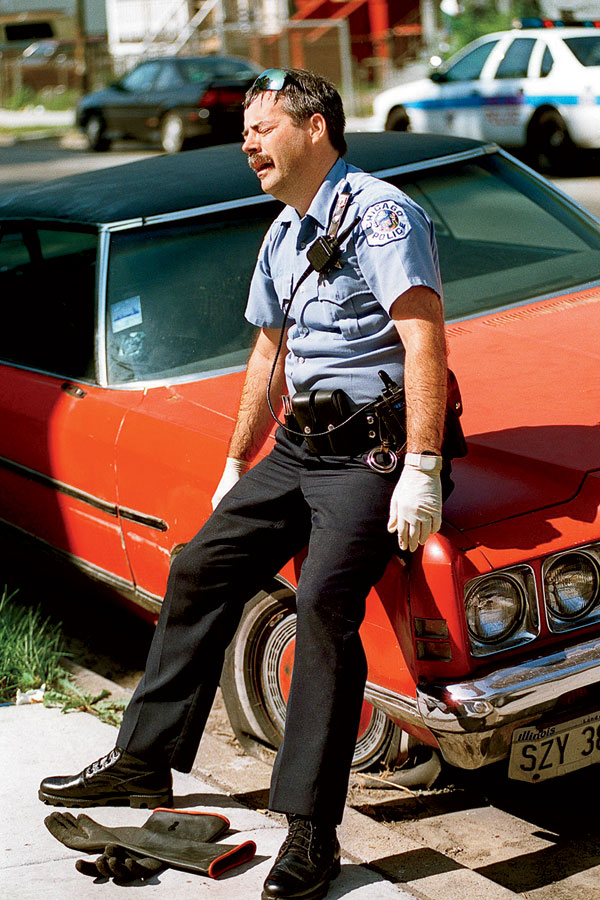
Cory Franklin
Director of medical intensive care at Cook County Hospital
Outside of the intensive care unit, the open wards had no air conditioning. They were so hot that we actually had three or four older people with cardiac problems who suffered heat stroke while they were in the hospital. Once we started getting a couple of deaths, that got everybody’s attention, and portable air conditioners were brought in.
John Jay Shannon
Internist and critical care physician at Cook County Hospital
You’d be walking around the hospital, and the doctors, the nurses, the patients would all be sweating like mad. It was unbelievably hot in the operating rooms. Ghastly. We had to do more rotation of staff than normal because they were soaking through their scrubs.
Dr. Franklin
We only got the extreme patients [in the ICU]. There was a much worse backlog in the emergency room. I had to venture down there for the sickest people, and it was sort of Gone with the Wind Atlanta in 1864. The worst case was a construction worker. He had been working on a hot tar roof. He had a temperature of 111 and was in a coma when he came in. [In these cases] you stop sweating because you bypass the sweating mechanism, so your skin is very hot and dry. Inside, you can get liver failure, the organs and muscles become very, very damaged, and it’s a question of whether or not your brain will survive. He was lucky. He survived.
Friday, July 14
Even as the heat wave entered a suffocating second day, with a high of 102 at Midway, City Hall officials seemed to be largely unaware of the disaster unfolding around them. To further complicate matters, about 10 packed-to-capacity emergency rooms went on “bypass” mode, meaning they weren’t accepting new patients. On the North Side, as many as 49,000 residents lost power for much of the weekend after multiple Commonwealth Edison transformers blew, rendering air conditioners useless.
Richard M. Daley
Mayor of Chicago (at a City Hall press conference)
It’s hot. It’s very hot. Yesterday we broke records. We all have our little problems, but let’s not blow it out of proportion. It is a crisis. It’s hot out there. We all walk out there. It’s very, very, very hot. It’s like getting heavy snow. It’s like getting real cold weather. Yes, we go to extremes in Chicago. And that’s why people love Chicago. We go to extremes.
Andy Shaw
Political Reporter for ABC-7
I think Rich Daley tended to be cavalier, initially, about weather situations. He tended to laugh off concerns because extreme weather is so common in Chicago. I think he saw weather preparedness almost as a silly exercise.
Meteorologist Skilling
I remember going home to the North Side from work, and it was like a Third World country. The whole area was dark. People were walking around with flashlights. I’ve driven down Addison Street for I don’t know how many decades. I didn’t recognize it.
Paramedic Mroczek
Emergency Medical Services was already hiring additional guys and putting on extra ambulance companies to help adjust for the overabundance of runs. We were crossing three to five districts, trying to get to different locations. Our response times were anywhere from 20 to 45 minutes instead of the usual four to six.
Robert Starks
Head of the Task Force for Black Political Empowerment and professor of political science at Northeastern Illinois University’s Carruthers Center for Inner City Studies
We knew it was much more of a disaster than what the Daley administration was claiming because on the South Side and West Side we kept hearing about people dying. The hallmark of the Daley administration in regard to the African American community was “We’ll get around to them when we can.” Isolation [of residents] was part of [the problem], but the health department should have had people checking on the elderly. They should have had door-to-door contact with those people, taking them to cooling [centers], taking ice to them, taking water to them, and in some cases even installing air conditioners.
Paramedic Scipione
A lot of our older population, if they’re living in an area that’s marginal, they don’t want to open their doors to people. Or they have burglar bars on their front doors and windows. They pass out, and you can’t get in.
Paramedic Mroczek
It wasn’t unusual to see an older person sitting in an apartment with a sweater on because the temperature regulation systems in their bodies were going bad.
Tom Ryan
Firefighter
This guy’s neighbor had called 911 and said, “I haven’t seen him in a couple of days.” He was elderly. So they sent us over to check on him. We found an open window and I got boosted up, crawled through. We found the man in his kitchen. He’d been dead for well over a day.
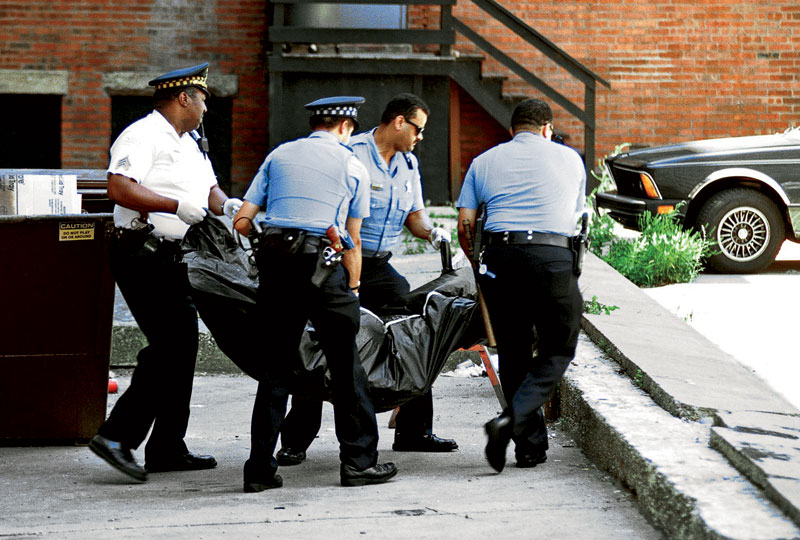
Two of the heat wave’s earliest victims were also its youngest. Daycare provider Margaret Ortiz left three-year-old boys Geno Rouse Jr. and Kenneth Brown Jr. in the back of her Ford Bronco after a midday field trip to the movies with eight other children. They were found more than 90 minutes later, unresponsive. Both died of heat stroke. Ortiz pleaded guilty to two counts of child endangerment and was sentenced to two years’ probation.
Atondra Rouse
Mother of victim
My husband called me at work downtown and said they had to take little Geno to the hospital. And I’m like, “No! What?” I’m getting crazy. I’m trying to get my things together so I can leave, and then he said something like, “Go to your mother’s house.” So my boss and I took a cab to my mother’s house, but nobody was there. I called my husband again, and he said, “I’m sorry. He’s gone.” Just like that. I fell on the floor and was beating the floor, screaming. There’s just a tremendous hole, a pain, and you just cry until you can’t cry anymore.
Edmund Donoghue
Chief medical examiner for Cook County
I got a call from my office about nine o’clock Friday night, and they said, “Dr. Donoghue, we just wanted to inform you there are 40 [autopsy] cases on the list for tomorrow.” In the history of the medical examiner’s office, we had never had that many cases. I said to the investigator, “What do you think is causing this?” And he said, “I think they’re dying of the heat.”
Saturday, July 15
On the last day of the heat wave, temperatures reached 98 and the humidity remained high.
Sarah Pang
Deputy chief of staff for Mayor Daley
The first time we really jumped into emergency mode was when I got a call from Jack Townsend [the first deputy police superintendent]. I don’t recall if that was late Friday night or very early Saturday morning. When he called late at night or early in the morning, your stomach would drop because he was not calling to say something good had happened—ever. He said, “We’re getting calls from [police] squads all over the city that people are passing away in their apartments.” I called my deputies and Roger Kiley [the mayor’s chief of staff] and said, “We need to go meet at City Hall and figure out what’s going on.”
Roger Kiley
Chief of staff for Mayor Daley
To be honest, we didn’t have a plan for anything like this because nothing like this had ever happened before.
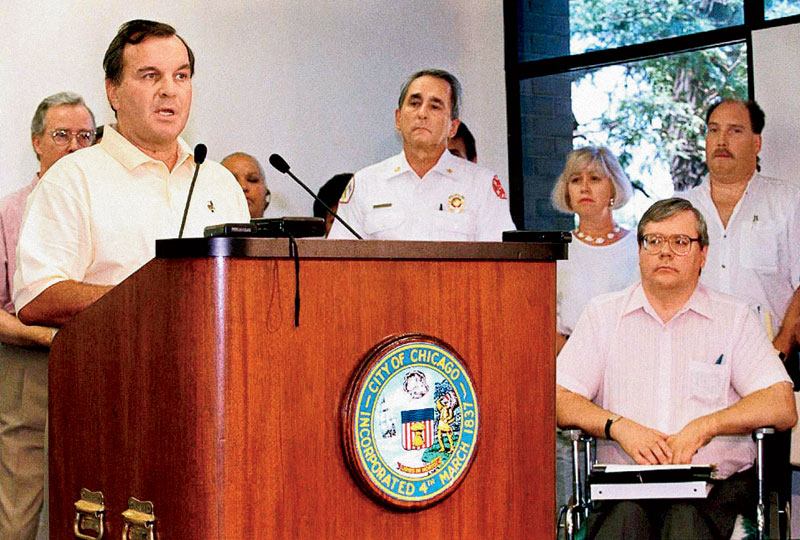
Deputy Chief of Staff Pang
Chicago was very skilled at managing snow removal and extreme cold. We understood that extreme cold was very dangerous. We did not fully understand that extreme heat, particularly over a number of days, was as dangerous as it was.
Medical Examiner Donoghue
By the time I got in on Saturday, there were 100 cases.
John Wilhelm
Bureau chief of the Chicago Department of Public Health
I was home [in downtown Chicago] on Saturday morning. One of the local TV stations wanted to talk with me about the heat wave. As I went to meet the TV person, I was thinking that the temperature was probably on the downswing. When we started, the interviewer said to me, “Are you aware that there are paddy wagons lined up at the medical examiner’s office with bodies?” Well, I wasn’t aware that there were bodies. The police hadn’t called to tell me. No one had called to tell me. I think everyone was in the moment and not putting the pieces together yet. When I finished the interview, I went upstairs and called Dr. Donoghue and said, “Ed, what’s happening?”
Late Saturday morning, while the mayor vacationed at his summer home in Grand Beach, Michigan, health department officials declared a citywide heat emergency. Before long, all of the city’s 56 ambulances and 600 paramedics were pressed into service. The number of emergency rooms that were no longer admitting people jumped to at least 16. At the Cook County morgue, four blocks from the old Cook County Hospital building on West Harrison Street, a cavalcade of police vehicles and ambulances delivered one corpse after another. Not since American Airlines Flight 191 crashed at O’Hare in May 1979 had the morgue been so busy. By the end of the day, the death toll would reach 269.
Medical Examiner Donoghue
Some of the bodies were decomposed, but all were visually identifiable for the most part. The toughest part was keeping up with the paperwork to do death certificates. And then we needed expanded refrigeration capacity to store the bodies. In our mortuary refrigerator, the capacity was 200.
Mike Boehmer
Administrative assistant at the Cook County morgue
We had done a tabletop exercise at the fire academy in case there was a disaster, like a sarin gas attack on the city, and there were [representatives] from different agencies there. We role-played about scenarios and told [the representatives] that the medical examiner would need a place to store bodies: refrigerated trucks. A guy from the city said they could provide those resources. I kept his number, and he’s the one I called.
Deputy Chief of Staff Pang
We brought in a couple of trucks at first and realized we needed more. There was literally no place else to put anybody.
Medical Examiner Donoghue
We could see that our autopsy technicians needed help with moving the bodies, so we called in students from the Worsham College of Mortuary Science. Later, we obtained help from the Cook County Sheriff’s Work Alternative Program.
Karl Koball
Worsham student and morgue volunteer
I was living on Clark Street in the Rogers Park area in an old brick building with no air conditioning. I had my windows open, but we didn’t have them on all sides, so there was no cross ventilation. I was lying in a bathtub of cold water, trying to cool myself down, when the call [to help at the morgue] came in.
Daniel McCarthy
Worsham student and morgue volunteer
I watched families coming in and trying to do positive identifications. There were droves of people arriving all at the same time, all with the same concerns, all with the same kind of emotions. You wondered whether or not part of their grief was compounded by the fact that maybe they didn’t check on Grandma or Grandpa or their aunt or uncle.
Joe Adolf
Worsham student and morgue volunteer
It’s tough to see that expression of helplessness and the genuine look of lost love.
Morgue volunteer Koball
We were just moving nonstop for hours and hours and hours and hours, into the night, into the next morning, into the afternoon, into the evening, and into the night again. You couldn’t help but think, There is somebody’s grandmother. There is somebody’s dad. There is somebody’s mom. There is somebody’s daughter. It’s almost crippling when you start to look at each individual casualty. Trying to not personalize it is difficult, but you just had to keep focusing on getting the job done correctly. In addition to the physical work, we had to be quite careful in identifying these casualties without any errors. That was job number one.
Sunday, July 16
Although the heat wave broke on Sunday, with the day’s high temperature a more manageable 93, the situation remained dire as 911 calls continued to pour in and more bodies were discovered. The death toll would reach nearly 400 by the end of the day. The county morgue was overwhelmed; 15 pathologists had to perform autopsies wherever space was available, including in its hallways. At City Hall, Daley’s staff scrambled to deal with the escalating crisis and the intensifying media barrage. Reporters wondered why the city had waited two full days to declare an emergency; why its plan for extreme heat, which called for cooling centers to be opened and public advisories to be issued, hadn’t been enacted earlier; and why police officers weren’t asked sooner to check on seniors.
Chief of Staff Kiley
I got a sense that the [casualty] numbers were pretty high, so I called the mayor first thing Sunday morning. He came into the office and got all hands on deck.
Deputy Chief of Staff Pang
There was a core group of people: the chief of staff, me, my deputies, fire department, police department, streets and sanitation, the water department, and the health department. The mayor was in command. When he heard about the emergency rooms, the number of victims, and realized that [the effect of] heat is cumulative and there would be more deaths, he was frustrated and emotional. It was a humanitarian crisis in his city that could never have been imagined. He was upset that it had happened, that we had not been able to foresee it.
Public Health Bureau Chief Wilhelm
The most painful part was counting the bodies. I would open my door in the morning, and on the front page they had a body count along the side. By 5:30 a.m., the medical examiner had already called to tell me how many bodies came in overnight, which was obviously higher than what was in the paper.
Matt Rodriguez
Superintendent of the Chicago Police Department
It was very frustrating in terms of trying to get information out to individuals to check on their loved ones, or even their neighbors, and to report any problems. Lives could have been saved. It was almost like watching the first plane hit the World Trade Center and then seeing the second one crash into the second building. You can’t do anything about a situation that’s out of your hands.
David Cavazos
Police officer
Volumewise, it was just incredible. I was preprinting some reports at roll call just to expedite the paperwork. We were hoping every day that people would listen to the news or read the paper or that the community groups that went out to check on people would bring them into the cooling centers. People were told, “Go to the mall.” And I was like, “Are you kidding me? Roseland doesn’t have a mall.”
Gabriele Kuhn
Friend of a victim
I helped [Mabel Swanson, who lived next door to Kuhn in the 3000 block of North Clifton Avenue in Lake View] with things around the house, and we got to be fairly close. She didn’t have air conditioning. She also had a heart condition, and she really didn’t leave her house. Her nephew had tried to install a window air conditioner a few years before, but it always blew [a fuse], so she said forget it. I asked her if she wanted to come over, but she was not comfortable walking and said she’d be fine. I brought over some fans and set them up. I also gave her a washcloth with a little tub of water and said, “Just wet yourself and stand in front of the fan. It’s cooler.” The next day I called her and she wasn’t answering, so one of my daughters and I went over to the house. [Swanson] was lying there on the bathroom floor. By that time, she was already sort of a blue shade. It was devastating. You think about it afterwards: If only I would have made her come over. But you can’t make somebody if they don’t want to.
Deputy Chief of Staff Pang
I rode around with Jack Townsend in those first days. The whole city was in mourning and in shock, to a degree. You’d get out of the car and walk around and talk to neighbors, and there was a sense of disbelief and sadness.
Officer Cavazos
I vividly remember a guy at the YMCA on East 111th Street. He was about 300 pounds. They found him sitting in a wooden chair, but he had kind of melted over the chair. The flies and the maggots had gotten to him and eaten off his whole face. The skin bubbled up with pressure [from various gases given off by a corpse], and you could hear him kind of oozing. It was bad. We were below on the first floor, and you could smell it. I don’t even know how to describe the odor. Boiling cabbage and burnt turnips smelled better. This old-timer told me, “Hey, kid, get some menthol cigarettes, break off the cigarette, open up the filter, and just ram those two pieces up your nose.”
Monday, July 17
In the morning, Mayor Daley met with his cabinet to devise a plan for further action. Meanwhile, at Daley’s request, Governor Jim Edgar declared Cook County a disaster area, the first step in triggering federal relief funds. At a news conference, Daniel Alvarez Sr., the commissioner of the Chicago Department of Human Services, referred to heat wave victims as “people that die because they neglect themselves” and immediately became an object of media and public scorn. Alvarez quickly apologized, saying his comments had been misinterpreted.
Daniel Alvarez Sr.
Commissioner of the Chicago Department of Human Services
A newspaper reporter quoted me wrongly as saying that people had neglected themselves. That means, in my limited English language, that we offered help and they refused. They refused to understand that there was a problem. I was sending my staff to houses. They knocked on doors: “Can I help you?” [Some residents said,] “Who are you?” “I’m from the Department of Human Services.” “Get out of here! I don’t want anything to do with the City of Chicago! You’re a bunch of politicians!” They rejected help. These were elderly people, and they had fear of letting strangers come into their houses. Many of them only answered at the windows. They didn’t open their doors.
Reporter Shaw
I’m not sure City Hall was equipped to do anything about this. This wasn’t a function of getting the plows out and cleaning streets and alleys. This was people having to check on the most vulnerable folks they know. How is the city going to know how many elderly people live alone, without air conditioning or anyone to check on them, or who has preexisting conditions that make them more susceptible to heat-related trauma? If you want to blame anybody, blame the aldermen. Blame the block clubs. Blame whoever failed to step up and protect people in the neighborhoods.
Tuesday, July 18
A major point of contention between City Hall and the medical examiner’s office was the body count, which at that time was 436 but would escalate by nearly 70 percent once additional autopsies and other studies were conducted. Were the deaths truly all heat related? In the Tribune, the bureau chief of the Chicago Department of Public Health deemed the chief medical examiner “liberal in his position” for determining heat deaths based on a body temperature of at least 105 degrees or an unusually warm residence, plus some deductive reasoning. Meanwhile, more refrigerated semitrailers—there would eventually be 10—rolled into the morgue’s parking lot for body storage.
Public Health Bureau Chief Wilhelm
We just wanted to be sure the body count was correct. And I think that initially Dr. Donoghue took my question as doubting. To me, it was just a momentary question and an answer. We were busy. We moved on. As I recall, he really didn’t move on, and I was surprised to see [his] comments in the newspaper that the mayor was questioning him.
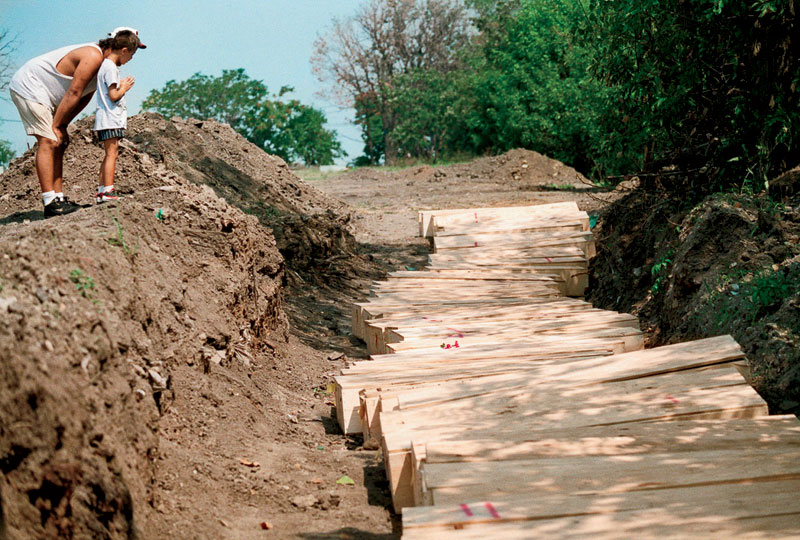
Medical Examiner Donoghue
When [City Hall] started accusing us of exaggerating the numbers, we said, “No. In fact, we’re confident that when it’s all over, we will have underestimated the numbers.” If you’d been over at our office and seen all the bodies and all the trucks, you wouldn’t be raising any questions. Most people who were living in air-conditioned spaces didn’t really understand it.
Mike Royko
Chicago Tribune writer (from his July 18, 1995, column, “Killer Heat Wave or a Media Event?”)
The difference [between heat waves of the past that killed hundreds and the one of 1995] is that when poor Gramps croaked in those days, nobody got to see him being wheeled into the morgue on the 10 o’clock news.
Morgue volunteer Koball
I don’t believe that even a seasoned funeral director would have been prepared for what we saw those few days. It was a human tragedy on a scale that nobody can really be prepared for. Afterwards, I was driving up north to my apartment in this old beater of a car I had, and the smell on my clothes and the thought of what I had been through started really hitting me heavy. I pulled over to the side of the road and got sick.
Epilogue
On Thursday, July 20, five days after the heat wave officially ended but as the death toll continued to climb (autopsies would be conducted into October), Mayor Daley, who did not respond to interview requests for this story, fielded media questions during a luncheon event at the John Hancock Center. At a news conference just two days prior, he had conceded that the city “could have done better” in dealing with this catastrophe—the $2 million tab for which was covered by federal disaster relief. Now, though, he was more defiant, proclaiming, “My commissioners, my performance, and the city employees were excellent. I’ve got no criticism whatsoever.”
Not a single member of Daley’s team was fired as a direct result of the collective failure. Lessons, though, were learned—and almost immediately put into action. On July 28, as another round of high temperatures approached, the city was aggressively proactive in its response. According to a New York Times report, Chicago was “already opening air-conditioned centers, delivering ice to shut-ins, setting up telephone banks to check on the elderly and broadcasting warnings on television and radio.” In addition, the story noted, “the department of Streets and Sanitation delivered more than 1,000 electric fans to elderly people who live alone. And the city produced a ‘Keeping Cool’ brochure, which was being circulated in Spanish, Korean, Chinese, Polish, Vietnamese and English.”
Once shrugged off by Chicagoans as a geographic inevitability, extreme heat had finally and tragically earned the respect it deserved.



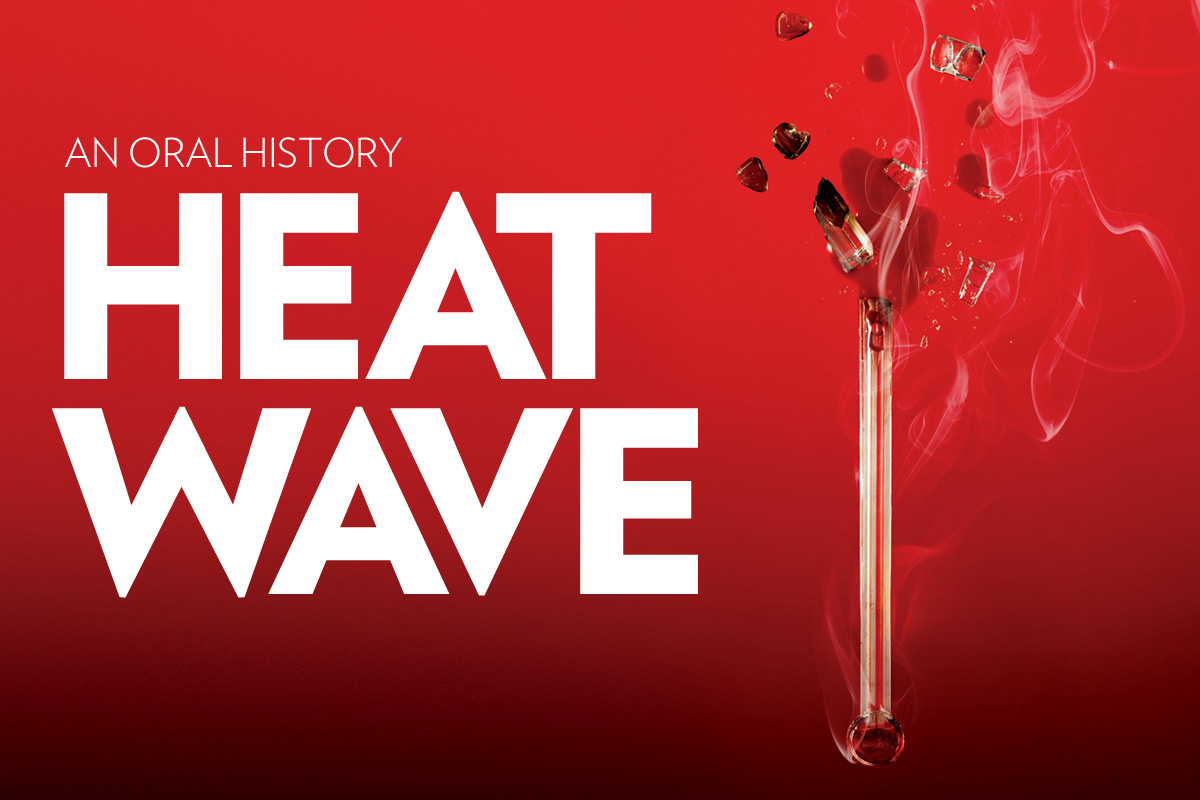
Comments are closed.